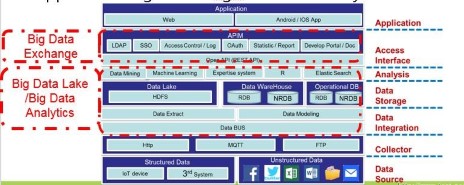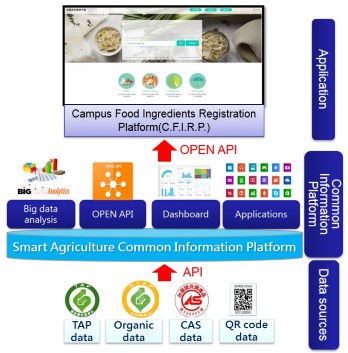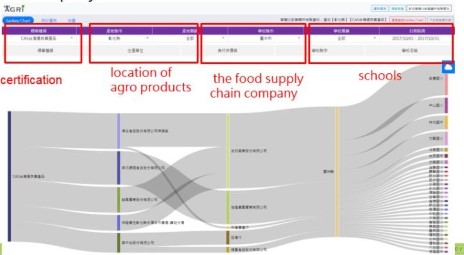Author:Lu, Chun Tang,Taiwan Agricultural Research Institute Crop Science Division
By deploying the next generation of agricultural production with supporting sales and tracking services, a common information platform (CIP) focused on comprehensive production, consumption and service is developed to raise the efficiency and predictability of agricultural production, as well as to enhance consumer confidence on the safety of agricultural products.
 The structure of agriculture common information platform
The structure of agriculture common information platformThe structure of agriculture common information platform can be divided into 7 layers from data source to application (Fig. 1), including data source, collection, integration, storage, analysis, access interface and application layer. For data processing, there are 3 categories in terms of big data exchange, big data lake and big data analytics. Production or environmental sensor/sensing technology, IoTs, other big data collection and analysis, production of required materials or traceability data collection and analysis are encompassed for the development of SA to effectively improve agricultural productivity and efficiency.
To create the convenient usage of agri-data and agri-digital service, the program integrated official data and open data such as weather, pesticide, fertilizer, food safety and market conditions is designed to share every stakeholder in agriculture sector by Open API mechanism (big data exchange). Each 3rd party vendors or research institutes can easily take advantage of the Open API to get agriculture data or digital service they need and develop innovative services to solve all kinds of farmers’ problems.
Besides providing agri-data, another assigned mission of the CIP is to provide agri-digital service, such as analysis of agricultural IoT data, big data analysis of heterogeneous agricultural data, etc. For example, the CIP helps the Ministry of Education to provide kinds of food safety certification data for Campus Food Ingredients Registration Platform.
In this case of big data exchange, the resources of 3LIQ data originally come from several different departments of Council of Agriculture (COA). To provide the Campus Food Ingredients Registration Platform for national primary and secondary schools with useful data, the CIP integrated these heterogeneous data and solved the data asynchronous problem. Therefore, this kind of big data exchange application based on agri-data integration and sharing can help the government to strengthen consumers' trust on food safety.
At present, types of big data lake of the CIP are divided into four categories, including the food safety database of agricultural and fishery products, the meteorological database, the pesticide/fertilizer database, and the market condition database. The number of data collection is over 100 million records with 37 items. The meteorological data collection is the largest (about 40 million records), the traceability data follow (about 12 million records), and the market data is the third (about 10 million records). The method of big data exchange adopts the Open API mechanism.
To date, totally 56 Open APIs have been provided for 3rd parties or research institutes. The 3rd parties or research institutes registered for the CIP have exceeded 25 units, and the usage frequency of Open API reaches nearly 450,000 times. The highest usage frequency of Open API is for traceability data of agricultural and fishery products.
 Big Data Exchange through Open API for food safety
Big Data Exchange through Open API for food safetyAccording to the policy of food safety, all primary and secondary schools (about 3,000) need to use traceable agricultural and aquaculture products tagged with the information of the “3L1Q.” The Campus Food Ingredients Registration Platform (CFIRP) of the Ministry of Education can get food safety information daily from the CIP by Open API mechanism to ensure safety of campus lunch (Fig. 2). This coordination of food safety information from platform to platform by Open API enable parents of the students to correctly and instantly understand what their children ate, and improve the convenience and benefit for 3rd parties in accessing food safety information.
 Sankey diagram of the food safety traceability chain for campus food
Sankey diagram of the food safety traceability chain for campus foodIn addition to data sharing, the CIP also develops digital services such as the analysis for food safety. By integrating heterogeneous food safety data with the traceability data of agricultural and livestock products and the materials used by the Ministry of Education on campus, a Sankey diagram can be used as an analysis tool to establish a food safety traceability chain (Fig. 3). Through selecting several parameters such as what kind of certification, date, production area, food company and school, the Sankey diagram can show very clearly that where and when the material of campus lunch come from and which food company cook. In other words, all traceable data can be displayed in a variety of ways by Sankey diagram to query different parameters needed. For example, if someone wants to know the traceability chain of the schools in Yilan County, Yizhen Group Food Center as shown providing most ingredients for Yilan’s schools need to be a targeted object for strengthening counseling and auditing. At the same time, the food suppliers and production areas are also included as counseling objects to reduce food safety scandals.
In Fig. 3, it also indicates how the Sankey diagram for heterogeneous food safety information works by selecting certification, location of agricultural product, food supply chain company, and county which school is located. Firstly, choosing what kind of certification you want in the left. Secondly, you can choose where the agricultural product with this certification is (location of production) and which food company to deal with these products. Lastly, you can choose the County and know these agricultural products are bought by which schools in the very county you care.